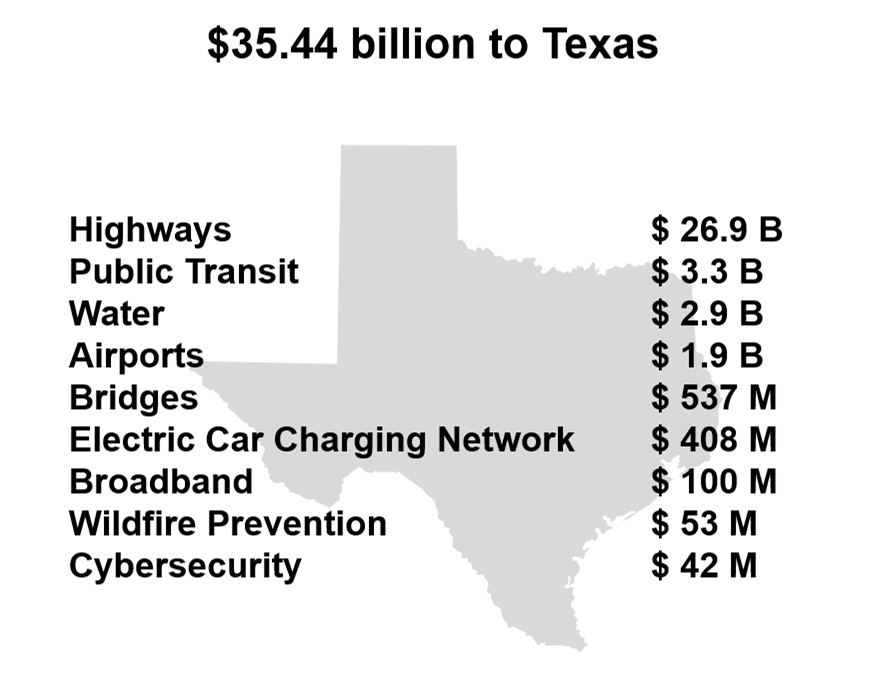Joe Oyler, Public Policy Managing Director
In 2021, the American Society of Civil Engineers gave Texas a C on its infrastructure report card, slightly above America’s grade of C-.
As Texas grows, so does its infrastructure needs. Texas’ total population ranks second in the country with a little over 29 million people. It ranks third in the country in largest growth rates at 15.91%. It’s also home to 30 major airports, 11 major ports, 196 major reservoirs, and a national-leading 683,533 total lane miles and 12,000 miles of freight railroad.
Congress has discussed passing federal infrastructure for years but could never agree on how to pay for it. In August 2021, the Senate, with bipartisan support, passed HR 3684: the Infrastructure Investment and Jobs Act (IIJA). The bill went back to the House of Representatives, and after months of intraparty protests and negotiations, Speaker of the House Nancy Pelosi brought the bill to the House floor for a vote. It passed, essentially along party lines, and President Joe Biden signed it into law on Nov. 15, 2021.
In Texas, not a single Texas Republican in the House or Senate voted for the bill, largely due to disagreements on how the bill would be paid for or if it would be paid for at all. In August 2021, the Congressional Budget Office estimated the bill would add $256 billion to the federal deficit over the next decade.
According to analysis conducted by Ernst and Young, infrastructure spending will be funded with the help of unspent pandemic relief funds, tax revenue from infrastructure improvements, recoupment of fraudulent unemployment benefits among other ways.
The IIJA allocates an estimated $1.2 trillion in total infrastructure over the next 10 years, including $550 billion in new spending over the next five years. Of the $550 billion, $284 billion will improve the nation’s surface infrastructure network and $266 billion will enhance core infrastructure in areas like broadband, power infrastructure, water infrastructure, environmental resiliency, and environmental remediation. The U.S. Department of Transportation will direct most of the new law’s investments. Several other agencies will also see their budgets increase.
The largest portion of the new federal spending ($110 billion) will be for roads and bridges.

Texas is projected to receive $35.44 billion, second to California. While most of the state’s money will go toward highways, roads, and bridges, other funds will be allocated for public transportation ($3.3 billion), water infrastructure ($2.9 billion), and broadband coverage ($100 million). To receive the internet funding, which is supported by grants, Texas will be required to submit a 5-year broadband plan to the National Telecommunication and Information Administration. View the full breakdown of the state’s infrastructure spending below.

How will this money help the Dallas Region? That remains to be seen. A few projects that could benefit over the next five years include:
-
-
- US 380 in Collin County
- I-635 and I-30 access road in Mesquite
- I-345 in Dallas
- State Highway 183 in Irving
- DART D2 and Silver Line projects
- DFW Airport Flyover Bridge
- Dam improvements to Joe Pool Lake
-
While the IIJA makes a record investment in our nation’s infrastructure, seeing the benefits will take time. Some parts of the current law will take significant time to implement, and on average, major road projects take seven years to complete.
It’s worth the wait. This historic investment in our infrastructure will create millions of jobs, spur economic growth, and improve the quality of life for all people. With the Dallas Region welcoming new residents and companies every day – a message our DRC delegation conveyed during our Washington, D.C. fly-in meetings – the DRC is pleased to see this legislation signed into law.